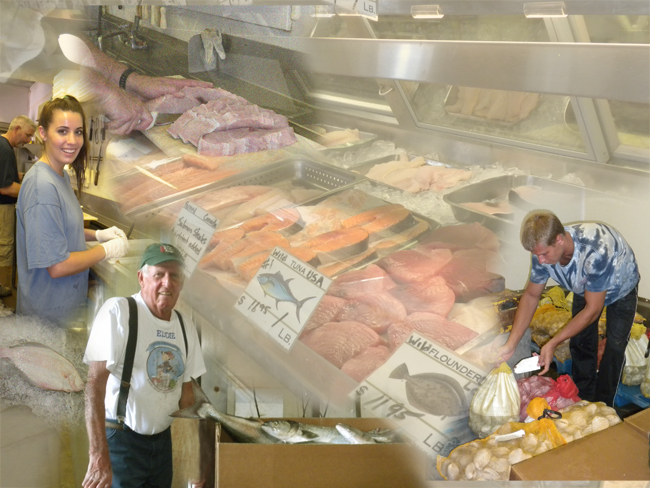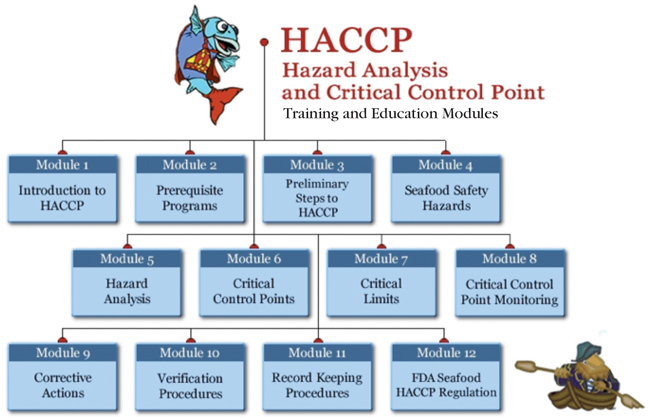In April 2011, the U.S. Food and Drug Administration (FDA) released the
first update in 10 years of its Fish and Fishery Products Hazards and
Controls guidance (FDA Hazards Guide) for seafood processors. These
changes – which describe appropriate science-based “HACCP” (pronounced
hassip), or Hazard Analysis Critical Control Point, controls for various
types of seafood products – impact our nation’s $60 billion seafood
industry, which employs some 250,000 workers.
Like Braun Seafood Company pictured above, all businesses that handle
seafood after it is unloaded from the fishing vessel or harvested from a
fish farm until it reaches the retail store or restaurant must apply
HACCP principles and develop a plan to prevent or control any food
safety hazards associated with their products and operation. “This
system is designed to help food processors produce safer food products
for consumers,” says New York Sea Grant’s Seafood Specialist Ken Gall.
Through proper training, seafood processors learn how to use the FDA
guidance to identify which food safety hazards (eg., harmful
microorganisms, toxic chemicals, additives, allergens, and/or physical
contaminants) are likely to be associated with their products or
processing operation. Based on this analysis, a system of controls is
developed at Critical Control Points (CCPs), or those steps in the
seafood processing operation – from receipt of raw materials to
processing steps and storage – where food safety hazards must be
prevented, eliminated, or reduced to an acceptable level.
While HACCP is not a “magic bullet” that will make all food safety
problems disappear, Gall says, “The process is designed to help seafood
businesses anticipate and prevent food safety problems before they
occur, rather than trying to fix or correct these problems after they’ve
already happened.”
Working with the National Seafood HACCP Alliance, FDA, NOAA’s National
Marine Fisheries Service, the U.S. Association of Food and Drug
Officials (AFDO), the National Sea Grant network and numerous other
partners, a standardized training program for the seafood industry and
federal and state inspectors was developed in the mid-1990s. The
original training program was a three-day workshop conducted by a team
of instructors. Several thousand individuals completed one of these
courses taught in NY by NYSG’s Ken Gall and trainers from the seafood
industry, FDA and the NYS Department of Agriculture & Markets. In
2000, Gall developed an alternative training format in which the first
two days of standard training are replaced with an Internet course, a
desirable alternative for businesses across the U.S. Gall reports over
5,800 people from all 50 states and 46 foreign countries have registered
for the Alliance’s Internet course. In total, over 28,000 people have
been trained through classroom and Internet courses since the program’s
inception.
 Behind-the-scene activities at Braun Seafood Company in Cutchogue, NY.
Behind-the-scene activities at Braun Seafood Company in Cutchogue, NY.
A fisherman weighs and ices his catch while workers inspect and store tagged shellfish and carefully handle each seafood product—
all to assure quality, safety and freshness for seafood consumers. Photos by Barbara A. Branca; Collage by Loriann Cody
After completing the Internet course (Segment One), individuals must
attend a one-day “live” Segment Two course to complete their training
and receive a certificate from the AFDO to demonstrate that they meet
the training requirement of the FDA regulation. NYSG’s Gall has taught
at least four of these one-day courses each year for the past decade.
Attendees at the Spring 2011 courses held in NYC’s FDA offices included
Philip Karlin,
founder of PE & DD Seafood in Riverhead, NY and a 43-year
commercial fisherman. This small, family-owned commercial fishing
operation offers wild-caught fish and seafood and is one of a handful of
local companies that sell their catch at NYC’s Greenmarkets.
Johnny Ortiz
from the Bronx’s Nebraskaland received training, too. Since its 1989
start, Nebraskaland has rapidly grown into the largest meat and fish
distributor in the NY metropolitan market, bringing it recognition in of
Crain’s Business Weekly as one of the top 200 privately-held companies.
Attendee
Nellie Wu, General Manager at W&T Seafood, a
family-owned and operated Brooklyn company, carries an array of fresh
and frozen fish, shrimp, and shellfish. “We only build partnerships with
the producers, farmers, and suppliers who are committed to our quality
standards,” says Wu. “In addition to focusing on our selection of
product, our primary concern is the health and safety of our customers.
We adhere to the FDA’s strict HACCP guidelines to ensure the safety of
our facilities and products.” The new edition of FDA’s Hazards Guide--a
450-page document--contains significant changes in control strategies
for various seafood safety hazards that needed to be shared with the
Alliance’s network of trainers as well as with the seafood industry and
government inspectors. In Summer 2011 the Alliance developed a half-day
workshop designed to explain the changes in the new FDA Hazards Guide
and help businesses incorporate the latest control strategies into their
HACCP food safety control plans and show inspectors how to evaluate
these new plans. Gall, who helped develop the workshop, taught the
course in San Francisco, CA and Providence, RI.

With the release of the new edition of FDA’s Hazards Guide, the National Seafood HACCP Alliance updated all of its training materials with Gall playing a lead role in their production. These new training materials will be used across the U.S. and in countries that export seafood to the U.S. for the next decade.
The Alliance is also conducting a series of trainer requalification programs for the several hundred trainers across the U.S. to introduce them to the new course training curriculum and teaching modules. Gall says, “The Alliance’s intent is to establish a uniform and standard training format for the seafood processing and importing industry and U.S. regulatory officials based on qualified trainers, current training materials, and approved courses.”
The NYS Department of Agriculture & Markets inspects seafood processors and recently adopted the FDA’s guidelines as state regulation. “State inspectors are required to complete seafood HACCP training before inspecting seafood processing firms, and so we use the course that Ken Gall teaches to fulfill this requirement,” says Erin Sawyer, Director of Field Operations for the department.
With many foreign seafood firms exporting their products to the U.S., Alliance training on HACCP-based FDA regulation compliance is crucial in other countries as well. In August 2011, Gall travelled to China with Dr. Steve Otwell of Florida Sea Grant and an AFDO representative to conduct a basic HACCP course and a train-the-trainer course that will qualify instructors to deliver Alliance training in China.
“Seafood is a complex commodity, the HACCP concept can be difficult for some to grasp, and the FDA guidance can be overwhelming for those who don’t know how to use it,” says Gall. “The Alliance training program provides seafood businesses with the knowledge they need to understand HACCP and the FDA’s regulatory requirements, and the skills needed to identify which food safety hazards are associated with their products and how they can be effectively controlled.”
— Paul C. Focazio